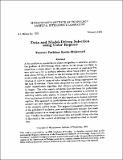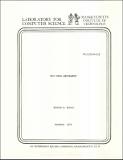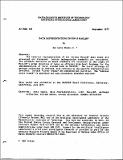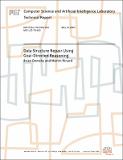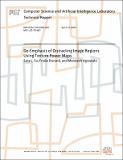Browsing Computer Science and Artificial Intelligence Lab (CSAIL) by Title
Now showing items 808-827 of 3804
-
Data and Model-Driven Selection Using Color Regions
(1992-02-01)A key problem in model-based object recognition is selection, namely, the problem of determining which regions in the image are likely to come from a single object. In this paper we present an approach that extracts ... -
Data and Model-Driven Selection Using Parallel-Line Groups
(1993-05-01)A key problem in model-based object recognition is selection, namely, the problem of isolating regions in an image that are likely to come from a single object. This isolation can be either based solely on image data ... -
Data Backup and Recovery in a Computer Architecture for Functional
(1985-10)The Vim computer system, an experimental project under development in the MIT/LCS Computation Structures Group, is intended to examine the efficient implementation of functional languages using the principles of data flow ... -
Data Communications via Cable Television Networks: Technical and Policy Considerations
(1982-05)Cable television networks offer peak communication data rates that are orders of magnitude greater than the telephone local loop. Although one-way television signal distribution continues to be the primary application of ... -
Data Driven Loops
(1980-08)The notion of the data driven loop arises in connection with our work in the Very High Level Language HIBOL and the automatic programming system (ProtoSystem I) that supports it. Although the concept is of general interest ... -
A Data Flow Architecture with Improved Asymptotic Performance
(1981-04)Large scale integration presents a unique opportunity to design a computer compromising large numbers of small, inexpensive processors. This paper presents a design for such a machine based on the asynchronous and functional ... -
Data Flow Computer Architecture Final Report
(1987-10)This report covers the work done by Computation Structures Group of the MIT Laboratory for Computer Science on developing models, languages, and architectures for data flow computation from 1966 to the end 1985. The work ... -
Data Model Equivalence
(1978-12)The current proliferation of proposals for database system data models and the desire for database systems which support several different data models raise many questions concerning "equivalence properties" of different ... -
Data Replication in Nested Transaction Systems
(1987-05)Gifford's basic Quorum Consensus algorithm for data replication is generalized to accommodate nested transactions and transaction failures (aborts). A formal description of the generalized algorithm is presented using the ... -
Data Representations in PDP-10 MACLISP
(1977-09-01)The internal representations of the various MacLISP data types are presented and discussed. Certain implementation tradeoffs are considered. The ultimate decisions on these tradeoffs are discussed in the light of ... -
Data Sharing in Group Work
(1986-10)Data sharing is fundamental to computer-supported cooperative work: people share information through explicit communication channels and through their coordinated use of shared databases. Database support tools are therefore ... -
Data Structure Management in a Data Flow Computer System
(1985-05)VIM is an experimental computer system being developed at MIT for supporting functional programming. The execution mechanism of the computer is based on data flow. This thesis presents mechanisms for managing data ... -
Data Structure Repair Using Goal-Directed Reasoning
(2004-05-18)Model-based data structure repair is a promising techniquefor enabling programs to continue to execute successfullyin the face of otherwise fatal data structure corruption errors.Previous research in this eld relied on ... -
Dataflow Architectures
(2/12/86)Dataflow graphs are described as a machine language for parallel machines. Static and dynamic dataflow architectures are presented as two implementations of the abstract dataflow model. Static dataflow allows at most one ... -
Dataflow Computation for the J-Machine
(1990-05-01)The dataflow model of computation exposes and exploits parallelism in programs without requiring programmer annotation; however, instruction- level dataflow is too fine-grained to be efficient on general-purpose ... -
DDD: Density Distribution Determination
(MIT Artificial Intelligence Laboratory, 1973-03-08)This paper presents a solution to the problem of determining the distribution of an absorbing substance inside a non-opaque non-scattering body from images or ray samplings. It simultaneously solves the problem of determining ... -
DDT Reference Manual
(1971-09-01)This memo describes the version of DDT used as the command level of the A.I. Laboratory Time Sharing System (ITS). Besides the usual program control, examination, and modification features, this DDT provides many ... -
De-Emphasis of Distracting Image Regions Using Texture Power Maps
(2005-04-12)A major obstacle in photography is the presence of distracting elements that pull attention away from the main subject and clutter the composition. In this article, we present a new image-processing technique that reduces ... -
Deadlock Detection in Computer Networks
(1977-09)The problem of detecting process deadlocks is common to transaction oriented computer systems which allow data sharing. Several good algorithms exist for detecting process deadlocks in a single location facility. However, ... -
Deadlock-free Sharing of Resources in Asynchornous Systems
(1970-09)Whenever resources are shared among several activities that hoard resources, the activities can attain a state of deadlock in which, for lack of resources, none of the activities can proceed. Deadlocks can be prevented ...
